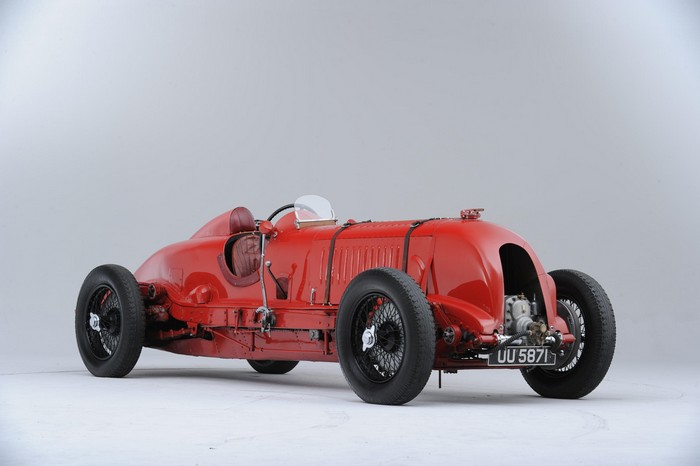SCM Analysis
Detailing
| Vehicle: | 1929 Bentley 4½ Litre |
| Years Produced: | 1929 |
| Number Produced: | 1 |
| Original List Price: | Immeasurable |
| Tune Up Cost: | $2,000 |
| Chassis Number Location: | Engine compartment firewall |
| Engine Number Location: | Stamped on engine bearer, blower number on front of blower |
| Club Info: | Bentley Drivers Club |
| Website: | http://www.bdcl.org |
This car, Lot 204, sold for $7,867,190, including buyer’s premium, at Bonhams’ Goodwood Festival of Speed sale on June 29, 2012.
Now this is a proper old bit of British tackle, from an age when drivers and cars were truly heroic, and is the exception to the W.O. Bentley rule that “the supercharged 4½ never won a race.”
The Paget/Bentley/racing story is a bit confuddled, but the basic consensus is that Paget was extremely wealthy and decided to invest in motor racing after having been a horse-racing backer. The racing world has traditionally gritted its teeth and put up with wealthy backers.
So, when Sir Henry Birkin, Bt (baronets inherit their title) wanted to go racing, and furthermore decided on a blown Bentley, of which its designer disapproved, it must have been a match made in heaven — or at least the concrete of Brooklands.
Birkin was a physically slight man. Brooklands is famously — and terrifyingly at high speeds — bumpy. Yet he managed to wrest 137 mph from this beast, sometimes with wheels off the floor.
You had to turn left or you’d slide over the top of the banking — into what’s now a housing estate. Many have been the times I have stood halfway up the curve of what’s left (about 300 yards) and wondered quite how they did it. It’s a haunting moment, and if ever you are in the U.K., I advise you strongly to make the trip to Weybridge, see the wonderful museum, wallow in history and then go and stand there yourself. Yes, there’s a sign there saying you shouldn’t, but these moments have to be snatched.
Same as it ever was
Still wearing the Villiers blower “No 1,” this car is roughly as Birkin got out of it, save now for a token speedo mounted in the left side of the cockpit to satisfy U.K. law (although the Isle of Man, where Daniels lived, is not part of the U.K., it forms part of the British Isles).
You might particularly enjoy the earlier speed estimation device, as speeds were marked on the rev-counter in top, based on 36 mph per 1,000 rpm. Doing the math, that is 126 mph at 3,500, 144 at 4,000 and a projected 160 mph at 4,500, although the upper figure was rather hopeful as the rev limit was set at 4,000 rpm.
“It can get very expensive around there,” said one-time owner Rusty Russ-Turner. Later he suffered a fatal heart attack at Silverstone while racing the car, after which it was acquired by George Daniels.
Robert Coucher, editor at large of Octane, got a chance to sample it at Goodwood and said, “The supercharged 4½ starts lazily and immediately emits that wonderful ‘bloody thump’ from its fintail exhaust: deep, mellow, typical of a large-capacity 4-cylinder engine running on low compression. The throttle pedal is located centrally, and just feathering it elicits an instant response from this lusty engine. On the move, the Bentley belies its lorry-like dimensions and is fast but well-behaved. The engine spins with verve (it was heavily reworked in its day), the big carbs suck hungrily and the blower provides instant torque. The chassis is composed and the ride is surprisingly comfortable, while the brakes are strong and reassuring.”
But the Birkin is no short-track sprinter. It is set up to crack 137.96 mph on the outer circuit at Brooklands. Rather “Tiger Tim” than me.
Price no object for provenance
This is a fairly unmodified piece of history, saved thanks to the patronage of watchmaker Daniels, who loved his 4½s, and it’s unrepeatable.
The price paid is almost irrelevant, as it was to the anonymous bidder who bought it on the phone, raising the bar from the opening suggestion of £1.8 ($2.8m) to £3m ($4.7m) in one go, and then, when the underbidder timidly suggested another £100,000 ($156,000), steamrollered back with a £3.5m ($5.5m) answering bid. At just over £4m ($6.2m), he responded with a £4.5m ($7m) punt, which blew away the opposition and secured the car. Well — and stylishly —bought indeed.
There’s nothing with which to properly compare it, except perhaps the original “Mother Gun” 1927 Le Mans runner (retired after an accident), which is also now a single-seater, or YW2557, the 4½ Litre Le Mans that finished third at Le Mans in 1929 and is coming up with Gooding & Co. on August 18, 2012, at Pebble Beach with an estimate of $5.5m–7.5m. The last “real” Blower not to sell at auction, five years ago in Geneva, was asking $4.25m, and this car easily surpassed that.
The money was always going to be huge, and, once past the number that the market felt would have fairly bought it, what’s another million between determined collectors? The main issue is: May we please see it run some more? ?
(Introductory description courtesy of Bonhams.)
